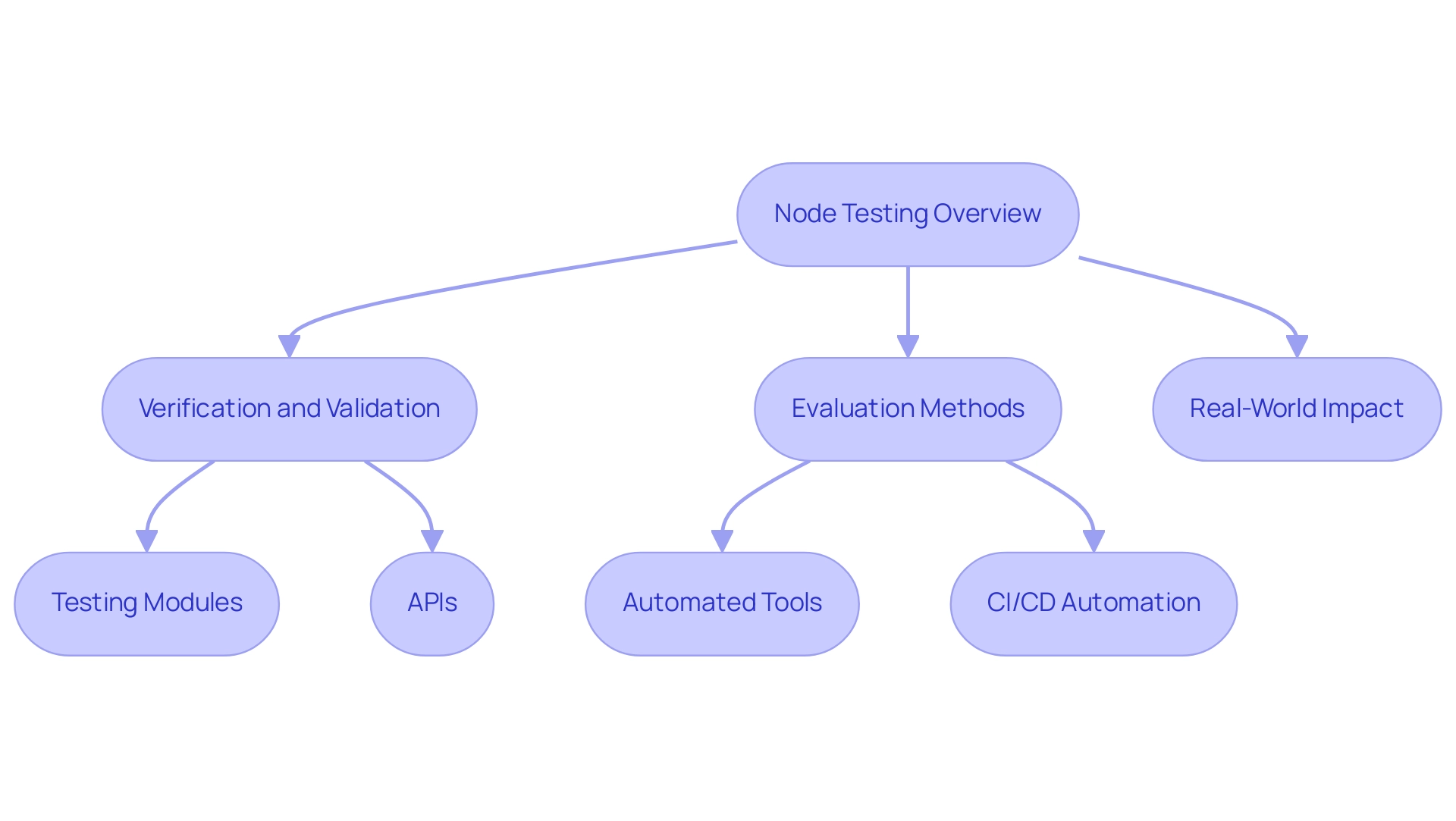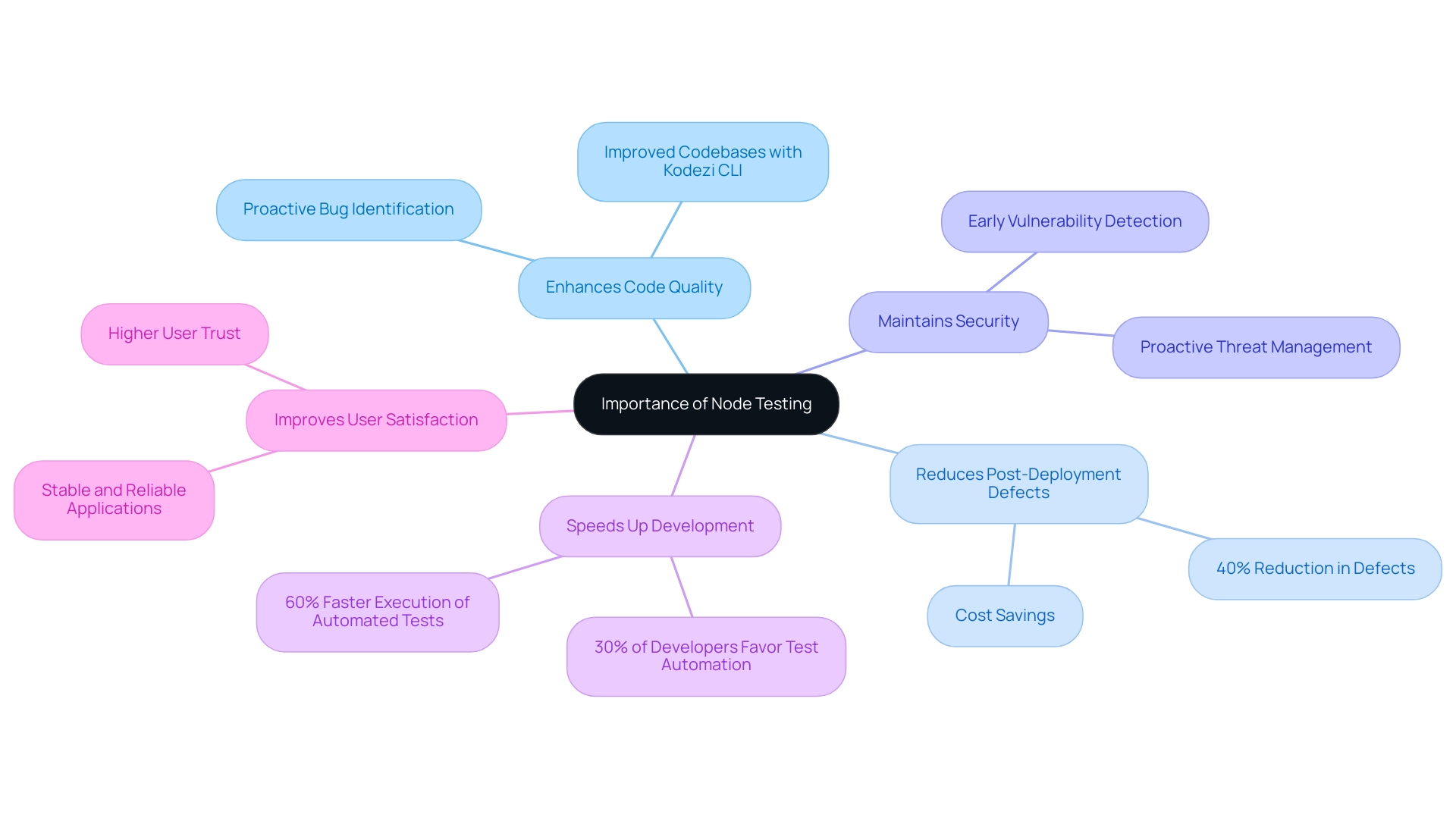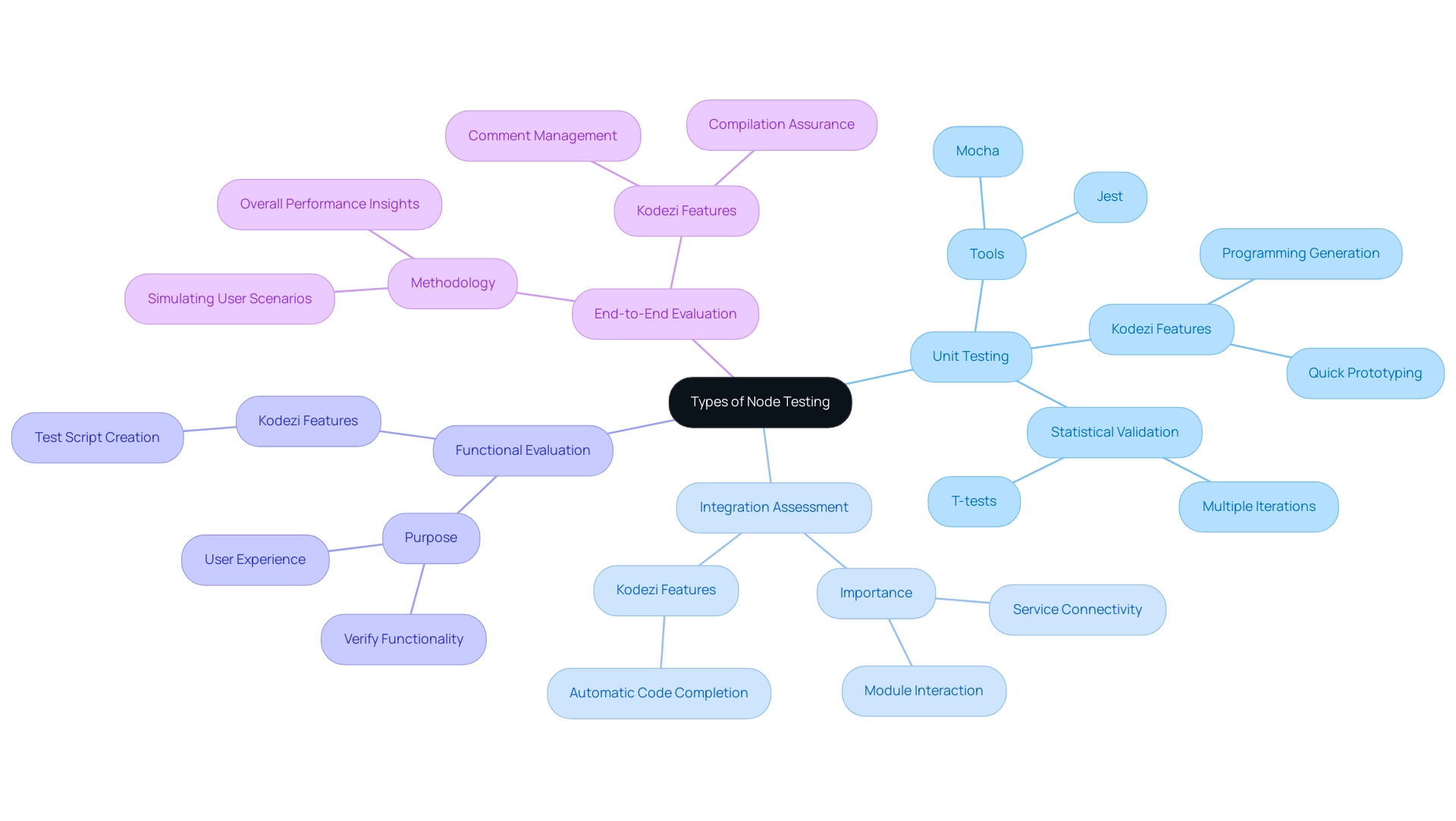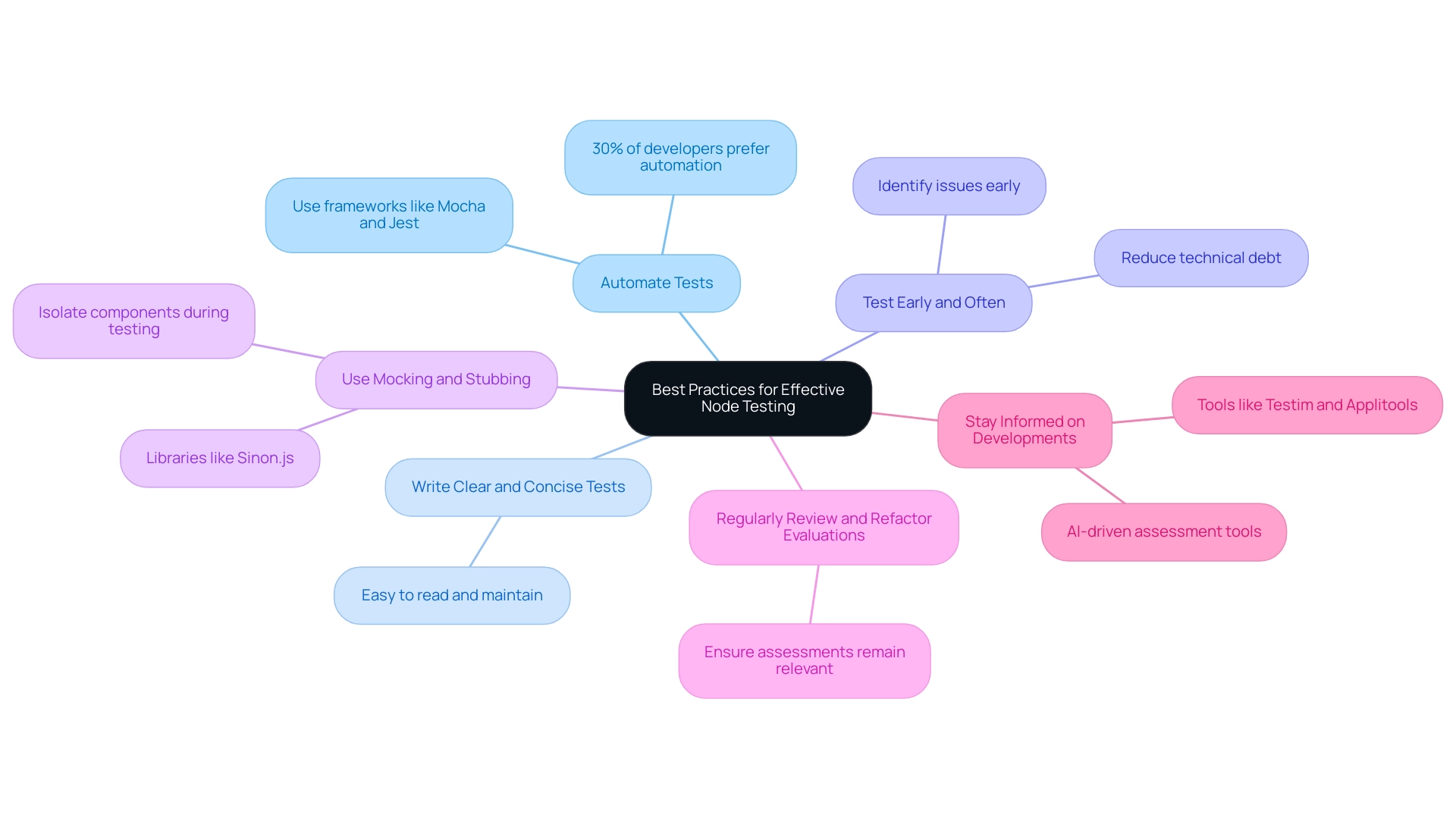Introduction
In the rapidly evolving landscape of software development, ensuring the reliability and performance of applications is paramount, especially for those built on Node.js. As developers strive to meet user demands and optimize their workflows, the significance of robust testing frameworks cannot be overstated. Node testing not only identifies potential issues before they escalate but also enhances code quality, paving the way for smoother deployment and superior user experiences.
With the integration of innovative tools like Kodezi, teams are empowered to automate and streamline their testing processes, resulting in faster development cycles and reduced costs. As the industry shifts towards more efficient methodologies, understanding the various types of Node testing and adhering to best practices will be crucial for maintaining a competitive edge in 2024 and beyond.
Defining Node Testing: An Overview
Node testing involves the verification and validation of Node.js software to ensure optimal performance and reliability. This process involves systematically running tests on various components, such as modules and APIs, to detect errors early in the development cycle. Such a structured approach is crucial for maintaining high code quality and performance, especially when developing scalable network solutions with Node.js.
Effective Node evaluation methods are crucial for developers seeking to build strong and efficient programs capable of managing real-world situations. For instance, GoDaddy reported a remarkable fourfold increase in end-user performance after switching to Node.js for its web hosting services, highlighting the tangible benefits of adopting this technology. Since implementing Node.js in 2016, GoDaddy has successfully reduced server load, cut costs, and enhanced user experience.
The widespread adoption of Node.js highlights the significance of rigorous evaluation practices, with the United States accounting for 39% of its users, followed by India and the UK. This expanding presence highlights the necessity for thorough evaluation frameworks to ensure applications satisfy user expectations across various regions. The correlation between a robust evaluation framework and superior performance metrics is evident in GoDaddy's results.
As we transition into 2024, the landscape of Node evaluation strategies continues to evolve, with trends highlighting the increased use of automated evaluation tools like Kodezi. These tools simplify the evaluation process and enhance CI/CD automation, allowing developers to quickly identify and resolve issues. Kodezi’s automated code debugging capabilities enhance software performance while ensuring security compliance and adherence to coding standards. By incorporating comprehensive and modern evaluation strategies, developers can significantly enhance application performance, reduce costs, and achieve higher user satisfaction. Thus, Node evaluation remains an indispensable aspect of the development process.

The Importance of Node Testing in Software Development
Node evaluation plays a crucial role in software development, significantly enhancing code quality by identifying bugs before they reach production. With Kodezi CLI, B2B engineering teams can autonomously improve their codebases and seamlessly fix bugs, ensuring a more efficient development process. Companies that implemented robust Node testing frameworks alongside Kodezi CLI reported a 40% reduction in post-deployment defects, leading to significant cost savings and improved user satisfaction. This proactive approach minimizes the risk of costly fixes after deployment, ensuring a more stable and reliable application. Kodezi's automatic bug analysis and code correction features further enhance this process, enabling teams to quickly Auto Heal their codebases and maintain consistent performance under expected loads, which is vital for user satisfaction.
Moreover, Kodezi aids in maintaining security by uncovering vulnerabilities early in the development process, allowing developers to address potential threats proactively. Test automation, favored by 30% of developers for its speed and efficiency, can be amplified with Kodezi, which has been shown to reduce development time and streamline the software development lifecycle. A recent study highlighted that automated tests could execute 60% faster than manual tests, enabling teams to deliver features more quickly.
Investing in Node evaluation, complemented by Kodezi CLI, ultimately leads to more reliable applications, higher user trust, and a smoother development workflow. Clear reports integrated with bug trackers provide detailed insights that drive continuous improvement. Groups employing Node evaluation approaches in conjunction with Kodezi have seen a 25% rise in overall software quality metrics. As software development continues to evolve, the significance of Node assessment in 2024 and beyond remains undeniable, delivering tangible benefits across the board. Testimonials from users emphasize how Kodezi has changed their evaluation process, making it not only efficient but also effective in producing high-quality software.

Types of Node Testing: An Overview
Maintaining quality in Node.js applications includes different forms of evaluation, each fulfilling a distinct role. Utilizing tools like the Kodezi Extension can further enhance efficiency in this process through its innovative programming generation and debugging features.
-
Unit Testing: This type focuses on verifying that individual components or functions perform as intended. Popular tools like Mocha and Jest streamline the process of unit testing in Node.js environments. With Kodezi's programming generation feature, both students and developers can produce intricate scripts by offering curated instructions or natural language pseudo-language, ensuring that their unit evaluations can be created and executed more efficiently. This capability enables quick prototyping of cases, which can significantly reduce the time spent on writing boilerplate code. As developer 'munk' suggests, running multiple iterations and performing simpler statistical tests like t-tests can help validate distributions and ensure the reliability of these tests.
-
Integration Assessment: This type of evaluation examines the interaction between different modules and services, ensuring they operate together seamlessly. Kodezi's debugging feature plays a crucial role here by automatically completing incomplete code inputs, which can streamline the integration evaluation process. Integration evaluation is particularly vital for systems that depend on numerous interconnected services, offering a thorough perspective on how various components connect.
-
Functional Evaluation: Functional evaluation verifies the software's functionality against specified requirements, ensuring that the end-user experience meets expectations. By utilizing Kodezi's functionalities, developers can swiftly create the required test scripts, enabling more comprehensive evaluation of the software's features. This kind of evaluation is essential for confirming that all features operate correctly and efficiently.
-
End-to-End Evaluation: By simulating real user scenarios, end-to-end evaluation assesses the application from start to finish. Kodezi's ability to manage comments effectively while ensuring compilation can enhance the accuracy of these tests. This method provides valuable insights into overall performance and usability, making it an essential component of a comprehensive evaluation strategy.
Kodezi's debugging feature ensures that code can be compiled by automatically completing incomplete code inputs while managing comments effectively. Case studies on evaluating statistical methods highlight challenges such as ensuring the sum of probabilities in a distribution converges to 1. Solutions include using an epsilon value for comparison and breaking down methods into testable components. Additionally, the significance of conducting numerous iterations and simpler statistical analyses can confirm results effectively, linking back to the importance of thorough evaluation methods.
By utilizing these varied evaluation methods alongside Kodezi's advanced features, developers can create a strong assessment strategy that addresses different aspects of software performance and reliability, ultimately maximizing efficiency in Node.js environments.

Best Practices for Effective Node Testing
To ensure optimal performance and reliability in Node.js applications, developers should adhere to several key best practices for Node testing:
-
Automate Tests: Utilizing automated assessment frameworks such as Mocha or Jest is crucial. These tools guarantee that assessments are carried out consistently and efficiently, significantly minimizing the need for manual intervention. Considering that 30% of developers now prefer automation over manual evaluation, this method is becoming increasingly vital.
-
Write Clear and Concise Tests: Crafting tests that are easy to read and understand aids in their maintenance and updates as the codebase evolves. This clarity is vital for long-term project success.
-
Test Early and Often: Incorporating evaluations throughout the development lifecycle, rather than only at the end, helps identify issues early and reduces technical debt. This proactive approach is key to sustaining high-quality code.
-
Use Mocking and Stubbing: These techniques enable developers to isolate components during testing, making it easier to identify issues without relying on external dependencies. Libraries such as Sinon.js can be especially beneficial for this purpose, as they enable precise results.
-
Regularly Review and Refactor Evaluations: Just as codebases require periodic refactoring, so do evaluations. Regular evaluations ensure that assessments remain relevant, effective, and aligned with the current codebase.
-
Stay Informed on Developments: Recent progress in automated evaluation, such as the introduction of AI-driven assessment tools, can further enhance efficiency. Tools like Testim and Applitools leverage machine learning to improve test accuracy and reduce maintenance overhead.
Adhering to these best practices can significantly enhance Node testing efforts. By implementing these strategies, developers can achieve improved application performance and reliability, ultimately leading to higher productivity and efficiency in their projects.

Conclusion
The significance of Node testing in software development cannot be overstated. It serves as a cornerstone for ensuring the reliability and performance of applications built on Node.js. By employing a variety of testing methods and leveraging advanced tools like Kodezi, developers can thoroughly validate their code, identify potential issues early, and enhance overall code quality.
The ability to automate testing processes not only streamlines workflows but also leads to substantial reductions in post-deployment defects, ultimately resulting in cost savings and improved user satisfaction.
As the landscape of software development continues to evolve, embracing best practices such as early and frequent testing, clear test writing, and the use of mocking techniques is essential. These strategies ensure that applications remain robust and responsive to user demands. Furthermore, staying abreast of advancements in testing technology, including AI-driven solutions, can provide teams with a competitive edge in 2024 and beyond.
In conclusion, integrating comprehensive testing frameworks and automation tools like Kodezi is crucial for any development team aiming for excellence. By prioritizing Node testing, organizations can not only enhance their application performance but also foster greater user trust and satisfaction. As the industry shifts towards more efficient methodologies, the commitment to rigorous testing practices will invariably pave the way for future success.
Frequently Asked Questions
What is Node testing?
Node testing involves the verification and validation of Node.js software to ensure optimal performance and reliability by systematically running tests on various components, such as modules and APIs, to detect errors early in the development cycle.
Why is Node evaluation important?
Node evaluation is crucial for developers to build strong and efficient programs that can manage real-world situations, as it helps maintain high code quality and performance, especially in scalable network solutions.
What benefits did GoDaddy experience after adopting Node.js?
GoDaddy reported a fourfold increase in end-user performance, reduced server load, cut costs, and enhanced user experience after implementing Node.js in 2016.
What trends are emerging in Node evaluation strategies?
As we transition into 2024, trends include the increased use of automated evaluation tools like Kodezi, which simplify the evaluation process and enhance CI/CD automation, allowing developers to quickly identify and resolve issues.
How does Kodezi improve Node evaluation?
Kodezi enhances Node evaluation through automated code debugging capabilities, ensuring security compliance, adherence to coding standards, and significantly improving application performance while reducing costs.
What types of evaluations are involved in maintaining Node.js application quality?
The types of evaluations include Unit Testing, Integration Assessment, Functional Evaluation, and End-to-End Evaluation, each serving distinct roles in verifying and validating different aspects of the application.
What are some best practices for Node testing?
Best practices include automating tests, writing clear and concise tests, testing early and often, using mocking and stubbing, regularly reviewing and refactoring evaluations, and staying informed on developments in automated evaluation tools.
What impact does test automation have on development?
Test automation can significantly reduce development time, with automated tests executing up to 60% faster than manual tests, enabling teams to deliver features more quickly and efficiently.
How can developers ensure their tests remain effective?
Developers should regularly review and refactor their evaluations to ensure they remain relevant and aligned with the current codebase, as well as implement clear and concise testing practices for easier maintenance.




